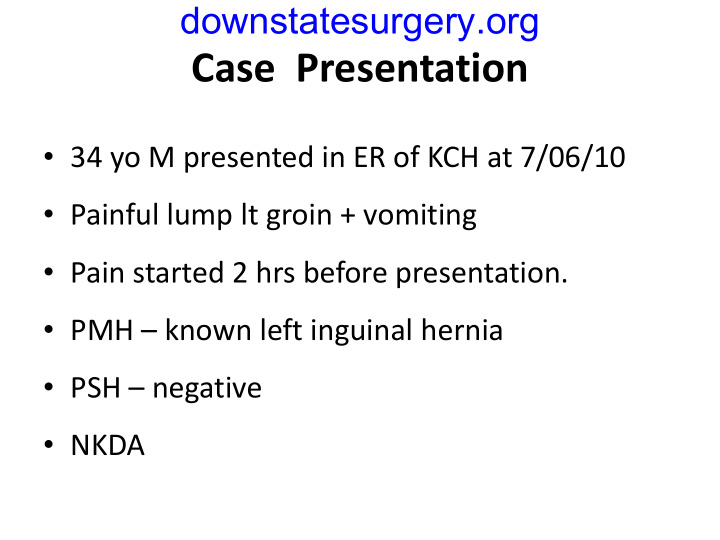



downstatesurgery.org Case Presentation • 34 yo M presented in ER of KCH at 7/06/10 • Painful lump lt groin + vomiting • Pain started 2 hrs before presentation. • PMH – known left inguinal hernia • PSH – negative • NKDA
downstatesurgery.org Case Presentation • VS: 146/93, 86 , 18, 98% • PE: – suffering from pain – Abdomen – not distended – Soft – minimal diffuse tenderness – Lt groin- painful, tender, irreducible mass – GU- both testicles in place
downstatesurgery.org Case Presentation • Labs: – WBC 6.9 – Lactate 3.6 – VBG pH 7.53, pCO2 29.8, HCO3 26.3, BE 2.2
downstatesurgery.org Case Presentation • Dx – Incarcerated inguinal hernia • OR finding/Procedure: – Lt inguinal incision – Strangulated , non viable SB in hernial sac – Serosanguinous fluid in the sac – Resection of SB with stapled anastomosis – Repair of hernia with Plug and Patch Bard Mesh
downstatesurgery.org Case Presentation • Postop course uncomplicated • Discharged home on POD # 4 when was tolerating regular diet and had BMs. • Readmission on POD # 7 for SBO
downstatesurgery.org
downstatesurgery.org
downstatesurgery.org
downstatesurgery.org
downstatesurgery.org • NGT/NPO/IVF • ABD XR on HD#2 – contrast in Rt colon, BM+ • HD#3 diet started • Discharged HD#4 • Patient visited OPC on POD #15 – doing well – postop scar intact
downstatesurgery.org Use of Mesh for Hernia Repair in in clean-contaminated field Dr V. Roudnitsky Downstate Medical Center
downstatesurgery.org Hernia repair • Primary repair ( tissue repair ) • Synthetic mesh repair • Biological mesh repair
downstatesurgery.org Long-term follow-up of a randomized clinical trial of non-mesh versus mesh repair of primary inguinal hernia British Journal of Surgery 2007; 94: 506–510 • Randomized prospective study • 1993-1996 randomization of 300 patients • No specialized hernia center Non mesh repair: • – Bassini 51% – Shouldice 20% – McVay 4%
downstatesurgery.org Long-term follow-up of a randomized clinical trial of non-mesh versus mesh repair of primary inguinal hernia British Journal of Surgery 2007; 94: 506–510 • 10 years follow up: – 80 patients non-mesh group– 17% recurrence – 73 patients mesh group – 1% recurrence • Half of recurrence occurred more then 3 y after the operation – adequate f/up is important
downstatesurgery.org A COMPARISON OF SUTURE REPAIR WITH MESH REPAIR FOR INCISIONAL HERNIA N Engl J Med 2000;343:392-8 • Multicenter randomized, prospective study • Suture repair vs mesh repair (100/100 patients ) • The three-year cumulative rates of recurrence: – suture repair 43 percent – mesh repair 24 percent • P=0.02 • Risk factor for recurrence: – Suture repair – Infection – Prostatism ( men ) – Previous surgery for AAA
downstatesurgery.org
downstatesurgery.org Abdominal hernia repair with bridging acellular dermal matrix—an expensive hernia sac The American Journal of Surgery (2008) 196, 47–50 • Retrospective review of 11 complex abdominal hernia repair with Acellular Dermal Matrix • All cases - bridging of fascial defect • Mean follow up 24 months • Recurrence rate 80%
downstatesurgery.org
downstatesurgery.org
downstatesurgery.org
downstatesurgery.org
downstatesurgery.org Experiences with a Prophylactic Mesh in 93 Consecutive Ostomies World J Surg (2010) 34:1637–1640 • Use of prophylactic mesh for prevention of parastomal hernia during creation of end colostomy • A prophylactic mesh was used in : – 19 of 29 (65%) dirty wounds – 56 of 64 (87%) contaminated wounds
downstatesurgery.org
downstatesurgery.org
downstatesurgery.org Experiences with a Prophylactic Mesh in 93 Consecutive Ostomies World J Surg (2010) 34:1637–1640 • Conclusion: – A mesh does not increase the rate of complications and can be used in severely contaminated wounds.
downstatesurgery.org Obturator hernia: clinical analysis of 16 cases Hernia (2008) 12:289–297 • Retrospective review of 16 patients with obturator hernia in 20 years period • 75% strangulated hernias with 56.3% perforation • Intestinal resection 12 cases • Repair with polypropylene 11 cases • Mesh was used in 6 cases of SB perforation • Mesh was used in 3 cases of SB strangulation/resection • Wound infection 4 cases • No need for mesh removal
downstatesurgery.org Tension-free repair versus modified Bassini technique for strangulated inguinal hernia: a comparative study Hernia (2005) 9: 156–159
downstatesurgery.org Tension-free repair versus modified Bassini technique for strangulated inguinal hernia: a comparative study Hernia (2005) 9: 156–159 • No significant difference of wound infection between the two groups (2/33, 6.1% vs 4/42, 9.5%, p=n.s.) • No mesh had to be removed.
downstatesurgery.org Early results from the use of the Lichtenstein repair in the management of strangulated groin hernia Hernia (2007) 11:239–242 • 25 patient with strangulated inguinal hernia vs 25 elective hernia repair • In group of strangulation bowel resection performed in 4 patients ( 16%) • No wound infection noted in both group
downstatesurgery.org Use of a preperitoneal prosthesis for strangulated groin hernia BJS Volume 84(3), March 1997, pp 310-312 • 35 Patients with strangulated inguinal hernia • 9 bowel resection for ischemia but no perforation • Midline preperitoneal approach • 2 postop wound infection neither in Pt with intestinal resection • No mesh had to be removed
downstatesurgery.org Elective Colonic Operation and Prosthetic Repair of Incisional Hernia: Does Contamination Contraindicate AbdominalWall Prosthesis Use? J Am Coll Surg 2000;191:366–372.
downstatesurgery.org
downstatesurgery.org
Recommend
More recommend